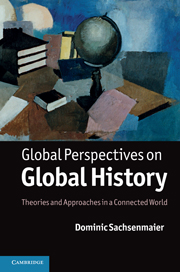Book contents
- Frontmatter
- Contents
- Acknowledgments
- Introduction Neglected diversities
- 1 Movements and patterns: environments of global history
- 2 A term and a trend: contours in the United States
- 3 On the margins of a troubled nation – approaches in Germany
- 4 Another world? Thinking globally about history in China
- Epilogue: Global history in a plural world
- Bibliography
- Index
1 - Movements and patterns: environments of global history
Published online by Cambridge University Press: 05 June 2012
- Frontmatter
- Contents
- Acknowledgments
- Introduction Neglected diversities
- 1 Movements and patterns: environments of global history
- 2 A term and a trend: contours in the United States
- 3 On the margins of a troubled nation – approaches in Germany
- 4 Another world? Thinking globally about history in China
- Epilogue: Global history in a plural world
- Bibliography
- Index
Summary
The question of traditions
The idea that in the future, global history may experience more sustained dialogues between scholars from different world regions leads to deeper theoretical challenges than may be apparent at first sight. Most importantly, there is the question of how to conceptualize “local” viewpoints in today's complex intellectual and academic landscapes. As I already argued in the introduction, plural approaches to global history cannot be simply based on celebrations of “otherness” or lip service to “authenticity.” While searching for greater levels of inclusivity, it is also necessary to consider the global condition of the field with all its networks, flows, and inequalities. After all, all over the world academic historiography has been at least partly the product of international power plays, worldwide transformations, and modern transfers. These translocal entanglements of modern historiography become particularly visible when we look at the field through global lenses and consider the epistemological as well as sociological changes that accompanied its spread to different parts of the world. Nevertheless, the globalization of university-based historiography did not lead to a standardization of scholarship all over the world.
- Type
- Chapter
- Information
- Global Perspectives on Global HistoryTheories and Approaches in a Connected World, pp. 11 - 58Publisher: Cambridge University PressPrint publication year: 2011



